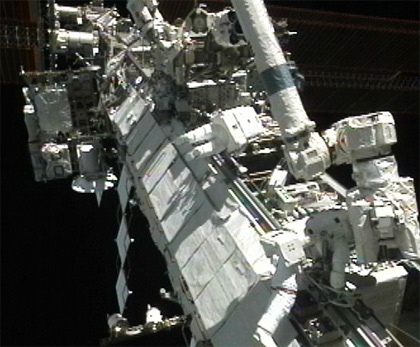Record-Setting Spacewalk at Space Station Falls Short on Repairs

Thisstory was updated at 3:43 p.m. ET.
Twoastronauts took an extra-long spacewalk outside the International Space StationSaturday to repair a crucial cooling system, but ran out of time before theycould replace a broken ammonia pump ? their primary goal. The delays stretched thework out into the longest space station spacewalk in history, NASA says.
NASAastronauts Douglas Wheelock and Tracy Caldwell Dyson had hoped to at leastremove the broken ammonia coolant pump and install a new one during their spacewalk.But a stuck ammonia hose, and later an ammonia leak, pushed them far behindschedule, preventing them from completing their work. [Graphic:Space Station's Cooling System ?Problem Explained]
Theexcursion lasted 8 hours and 3 minutes ? making it the longest spacewalk at thespace station without a NASA shuttle present and the sixth longest spacewalk inhistory. The record for the longest spacewalker ever is 8 hours, 56 minutes wasset by shuttle astronauts in 2001.
Saturday'sspacewalk was the first of two needed to complete the complicated repair. The nextspacewalk is set for Wednesday.
Theproblems for Wheelock and Caldwell Dyson cropped about four hours into thespacewalk, when one of four ammonia hoses they needed to disconnect stuck fast.
"Wow,that is not budging," Wheelock said as they spacewalkers fell behindschedule. The delays ultimately prevented the astronauts from disconnecting thestricken pump and installing its replacement. A second spacewalk is planned forWednesday to continue the work.
Get the Space.com Newsletter
Breaking space news, the latest updates on rocket launches, skywatching events and more!
Theastronauts began their spacewalk outside the InternationalSpace Station at 7:19 a.m. EDT (1119 GMT) as the outpost flew 220 miles(354 km) above Earth.
Stubbornammonia hoses
Theastronauts managed to disconnect the other hoses, some of which released frozenbits of ammonia coolant, which the astronauts said resembled tiny snowflakes.Any ammonia that attached to their spacesuits was expected to bake off in thesunlight.
Asidefrom the ammonia leaks, those hoses were disconnected swiftly.
"Don'tyou wish they were all that easy?" Mission Control radioed thespacewalkers.
Finally,the Wheelock returned to the stuck hose. He banged on it with a lever tool andmanaged to free it, only to see a large amount of ammonia leak out.
"Youcan see, it's got a pretty good snowstorm there," Wheelock said. "Boythat's a lot of pressure in there."
Theastronauts waited while Mission Control decided what to do and described theammonia flakes leaking out.
"Thatone looked like a giraffe," Wheelock said.
Ultimately,the astronauts left the hose connected to the faulty pump as time ran out.
Atone point, the carbon dioxide sensor inside Wheelock's spacesuit failed. As aprecaution, Mission Control told him to make sure to report any symptomsrelated to elevated carbon dioxide levels ? though none were reported.
Pumpfailure in space
The ammoniapump failed July 31, knocking out half of the spacestation's cooling system and forcing astronauts to turn off someexperiments and systems, as well as leave others without backups, in order toprevent the station from overheating. A tripped circuit breaker, likely causedby a power spike, caused the malfunction, station managers have said.
Spacestation managers have said the pump malfunction is a major failure for the12-year-old orbiting lab, enough so that engineers had already drawn up repairplans on the off chance it occurred.
The InternationalSpace Station uses liquid ammonia to cool its onboard systems bytransporting waste heat to a network of radiators mounted to its main truss.There are two main cooling system loops ? Loop A and Loop B. The failed pump isin Loop A, while the other cooling loop remains operational.
The failedammonia pump is located on the station's right side truss and will be replacedwith one of four spare pumps stored at the orbiting lab.
Each pumpweighs 780 pounds (353 kg) and is 5 1/2 feet long (1.6 meters) by 4 feet wide(1.2 meters). They are about 3 feet tall (almost 1 meter). Caldwell Dyson hassaid the pumps are about the size of a laundry dryer.
Wheelock andCaldwell Dyson were initially slated to perform a different spacewalk onThursday. That spacewalk was aimed at preparing the space station for futureconstruction work. Those tasks have been postponed.
Saturday'sspacewalk marked the first for Caldwell Dyson and the fourth for Wheelock.
- FAQ: International Space Station Cooling System Pump Failure
- Poll: Do We Need a New International Space Station?
- Graphic: Inside and Out: The International Space Station
Click here for space station missionupdates and SPACE.com'sNASA TV feed.
Join our Space Forums to keep talking space on the latest missions, night sky and more! And if you have a news tip, correction or comment, let us know at: community@space.com.

Tariq is the Editor-in-Chief of Space.com and joined the team in 2001, first as an intern and staff writer, and later as an editor. He covers human spaceflight, exploration and space science, as well as skywatching and entertainment. He became Space.com's Managing Editor in 2009 and Editor-in-Chief in 2019. Before joining Space.com, Tariq was a staff reporter for The Los Angeles Times covering education and city beats in La Habra, Fullerton and Huntington Beach. In October 2022, Tariq received the Harry Kolcum Award for excellence in space reporting from the National Space Club Florida Committee. He is also an Eagle Scout (yes, he has the Space Exploration merit badge) and went to Space Camp four times as a kid and a fifth time as an adult. He has journalism degrees from the University of Southern California and New York University. You can find Tariq at Space.com and as the co-host to the This Week In Space podcast with space historian Rod Pyle on the TWiT network. To see his latest project, you can follow Tariq on Twitter @tariqjmalik.









